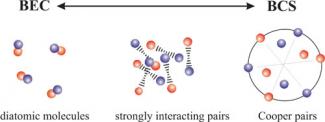JILA physicists are collaborating to explore the link between superconductivity and Bose-Einstein condensation (BEC) of fermions at ultracold temperatures. Fermions have an odd number of total protons, neutrons, and electrons, giving them a half integer spin, which is either up or down. At ultracold temperatures, this means fermions can't just occupy the same energy level (like bosons, which have an even number of atomic constituents) and form one superatom in a BEC. Instead, they stack up in the lowest energy states, with two fermions in each state, one spin up and one spin down, forming a Fermi sea.
Of course, the story is a bit more complicated. As researchers in Fellow Debbie Jin's lab showed last year, you can actually make a condensate from atomic fermions in two different ways: (1) by using two fermions to make a boson molecule, which can form a BEC or (2) by enticing fermions of opposite spin to become correlated (like permanent dance partners). The latter process is especially interesting because the correlated atoms behave a lot like Cooper pairs of electrons in superconductors. Of course, since electrons are fermions, this isn't a surprise. Physicists now think that superconductivity and superfluidity (mediated by Cooper pairs of fermions) represent one end of a continuum (with BEC on the other end) of quantum mechanical behavior.
One of the key questions in ultracold physics is how atoms behave in the middle of this continuum, called the BCS-BEC crossover. (BCS stands for the Bardeen-Cooper-Schrieffer theory of superconductivity developed in the mid-1950s.) Graduate Student Cindy Regal; former JILA Postdoc Markus Greiner, now assistant professor of physics at Harvard; former JILA Visiting Fellow Stefano Giorgini, now at Italy's Universitá di Trento; JILA visitor Marilù Chiofalo, and Fellows Debbie Jin and Murray Holland are tackling this question head on.
The researchers believe that the condensation behavior of Fermi systems evolves smoothly from BEC behavior (where most fermions have formed molecules) through the BCS-BEC crossover to Cooper pairs of atoms that form a superfluid, as shown on the right. In the crossover region, pairs of fermions interact strongly with each other. Depending on experimental conditions (in particular changes in the magnetic field), these pairs can behave more like molecules or more like Cooper pairs.
Murray Holland's theory team is currently working on developing a new theory to explain the quantum mechanical behavior of fermions in the BCS-BEC crossover. In the meantime, Cindy Regal and Debbie Jin continue to take advantage of an earlier analysis they performed that predicted that Feshbach resonances and magnetic tuning could be used to investigate atoms in this region. A Feshbach resonance is a special value of a magnetic field around which small changes in field strength have dramatic effects on the atomic interactions in an ultracold gas. In 2003, Jin's group used these predictions to observe the condensation of atom pairs in the BCS-BEC crossover. Since then, many experiments at JILA and elsewhere have used Feshbach resonances and magnetic tuning in experiments designed to improve science's understanding of crossover physics. Researchers continually compare the results of these experiments with different crossover theories.
Recently, the JILA researchers investigated the momentum distribution (velocity spread) of potassium (40K) atoms throughout the BCS-BEC continuum. Starting near the BCS end, the researchers gradually decreased the magnetic field while monitoring changes in the velocity spread of the ultracold atoms. As shown on the left, potassium atoms on the BCS side (the left side of the image) showed the least variation in velocity. The white, red, and yellow colors indicate a high density of atoms moving at the same velocity. By the time the researchers looked at the BCS-BEC crossover region (third from left), the atomic velocities were more spread out, with lower atom densities at one velocity, as evidenced by the green and light blue colors. The researchers think that atom pairs were not only getting much smaller, but that more pairs were forming. As the experimenters probed further toward the BEC end of the continuum, the velocities showed an even broader spread.
This experiment has provided enough information that Holland's group can now evaluate the strengths and weaknesses of different crossover theories. For instance, some theorists have applied superconductivity theory, developed for electrons in metals, to the BCS-BEC crossover region. However, this theory's prediction for atomic momentum distribution didn't come close to what was actually observed experimentally. Consequently, Holland and other theorists must now meet the challenge of developing a better understanding of crossover physics. A better theory will help the experimentalists know if they are actually probing fundamental physics. It could also have implications for condensed matter research, as Holland anticipates that it could shed light on the behavior of a variety of high-temperature superconductors, whose properties closely resemble those of fermions in the crossover region. - Julie Phillips




